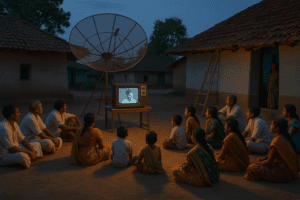Beyond the Rocket’s Glare: How a 50-Year-Old Satellite Experiment Lit Up Rural India
Fifty years ago, India’s pioneering Satellite Instructional Television Experiment (SITE) demonstrated technology’s power to transform lives beyond space missions. Partnering with NASA, ISRO beamed educational programs via satellite to 2,400 remote villages – many unelectrified – using innovative battery-powered TVs and massive antennas. This wasn’t just broadcasting; it was a meticulously crafted social mission.
Young engineers maintained near-flawless operations in harsh conditions, educators created localized content, and researchers lived in villages to measure impact. Driven by Vikram Sarabhai’s vision, SITE rejected space race vanity to directly tackle illiteracy and poverty. Its legacy includes decentralized community broadcasting models and a timeless lesson: technology’s highest purpose is solving human problems. Today, as India celebrates lunar landings, SITE@50 reminds us that uplifting marginalized communities remains space science’s most profound achievement.

Beyond the Rocket’s Glare: How a 50-Year-Old Satellite Experiment Lit Up Rural India
While headlines today chase rocket launches and billionaire space tourists, a quieter, more profound revolution in space technology celebrates its golden anniversary. Fifty years ago, India embarked on the Satellite Instructional Television Experiment (SITE) – a project that didn’t aim for the moon but instead reached into the heart of India’s most remote villages. Its legacy isn’t etched in lunar soil, but in transformed lives and a powerful, enduring philosophy: technology’s highest purpose is solving real human problems.
The Village Square Becomes a Classroom (August 1, 1975): Imagine a remote, unelectrified village in Odisha. Villagers gather around a television set powered by batteries, gazing in awe as moving images flicker to life – many witnessing such technology for the first time. This wasn’t entertainment; it was education beamed directly from space. NASA’s ATS-6 satellite, receiving signals from stations in Ahmedabad and Delhi, broadcast programs to 2,400 villages across six of India’s most disadvantaged states. Massive 10-foot antennas, precursors to today’s DTH dishes, made the impossible connection.
More Than Signals: A Symphony of Dedication: SITE wasn’t just a technical marvel; it was a triumph of human ingenuity and commitment.
- The Engineers: Young ISRO teams, led by visionaries like centenarian E.V. Chitnis, achieved near-miraculous uptime for TV sets in harsh, remote conditions, outperforming reliability in urban homes.
- The Programmers: Fresh graduates from FTII Pune, recruited specifically by ISRO, crafted engaging science education programs. Doordarshan created state-specific content, delivering localized agricultural advice and primary school lessons designed to “enrich” learning.
- The Social Scientists: Researchers lived in villages for 15 months, meticulously studying SITE’s impact – a rare commitment to understanding real-world effects.
- The Teachers: 45,000 educators received specialized training (in-person and via TV) in partnership with NCERT and the Education Ministry.
A Visionary Blueprint: Sarabhai’s North Star: SITE was the living embodiment of Dr. Vikram Sarabhai’s foundational vision for ISRO:
- Societal Impact First: “There is no ambiguity of purpose,” Sarabhai declared. Rejecting vanity projects and the “fantasy of competing” in lunar exploration, he insisted India must be “second to none in the application of advanced technologies to the real problems of man and society.” SITE proved space tech could directly tackle illiteracy, agricultural inefficiency, and information poverty.
- Self-Reliance & Collaboration: While the satellite was American, all ground hardware – the antennas, converters, and community TV systems – were designed, developed, and built indigenously. This blend of pragmatism and ambition became ISRO’s DNA.
- Decentralized Voices: Foreseeing the centralizing risk of satellite broadcasting, SITE birthed the Kheda Communications Project. India’s first district-level rural TV station empowered local participation, winning UNESCO’s inaugural Rural Communication Prize and pioneering the Low-Power Transmitter (LPT) model for national TV expansion.
The Real Legacy: Sparking Minds, Not Just Screens: Arthur C. Clarke hailed SITE as “the greatest communication experiment in history.” Its true success wasn’t measured in megabits, but in moments:
- The spark of understanding in a child’s eyes during a science lesson.
- Farmers adopting new techniques learned from area-specific broadcasts.
- Communities, irrespective of caste or class, gathering freely in panchayat ghars or schools, united by learning.
- As Kiran Karnik, a key SITE participant, reflects: “Probably in the one year of SITE, we learned more than the villagers.” The humility of listening was as crucial as the act of broadcasting.
SITE@50: A Beacon for the Tech Age: As India celebrates Chandrayaan landings and Aditya solar missions, SITE’s 50th anniversary offers a vital recalibration. It reminds us that amidst the awe-inspiring quests for scientific discovery, the most profound use of advanced technology remains its ability to uplift the most marginalized.
The question SITE continues to pose to technologists, policymakers, and society is timeless: Are we harnessing our most powerful tools primarily for spectacle and competition, or are we relentlessly focusing them, like Sarabhai did, on the “real problems of man and society”? In an era of AI hype and space tourism, the quiet revolution sparked in those 2,400 villages half a century ago shines brighter than ever as a model of purposeful innovation. The greatest missions aren’t always those that travel the farthest, but those that connect most deeply right here on Earth.
You must be logged in to post a comment.